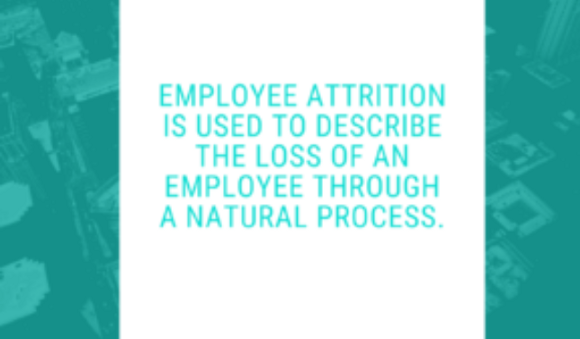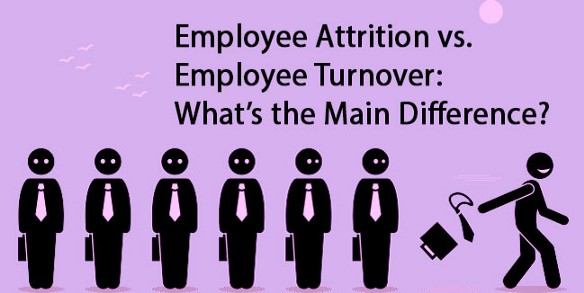Employee attrition and employee turnover both happen when an employee leaves the company. They also happen to be some of the most important recruitment metrics that recruiters use to measure their success. Without measuring these recruitment metrics, recruiters won’t be able to determine in which areas they’re doing great and where there’s room for improvement.
Although many people often use the two terms interchangeably, there’s a major difference between employee attrition and employee turnover.
Let’s explore the two terms and see what they mean for the success of your company.
What is Employee Attrition?
Emma has been working with her company for 25 years. She spent the majority of her professional career with the company, and today is her last day at work. She’s retiring but the company doesn’t plan on looking for a replacement. She’s considered part of her company’s employee attrition this year.
The case with Emma and her retirement is an example of employee attrition. Employee attrition is used to describe the loss of an employee through a natural process. When employee attrition takes place, an employer usually doesn’t fill the vacancy that’s left by the former employee.
In general, employee attrition applies to employees who leave the company due to:
- Retirement
- Resignation
- Elimination of a position
- Personal health


The Pros and Cons of Employee Attrition
Although the company is losing an employee, there are still several benefits to employee attrition, including:
- If the company is facing financial problems, employee attrition can help reduce costs.
- Employee attrition is a cordial departure from the company, unlike employee turnover.
Unfortunately, employee attrition also comes with a number of disadvantages, including:
- There will be a reduction in the size of the workforce.
- The job duties of the former employee may be transferred to the remaining employees, resulting in employee burnout.
- Employee burnout might lead to employee disengagement and lack of motivation.
- With a reduced number of employees, the company might have difficulties staying current and experiencing growth.
- The company might lose valuable employee knowledge and skills.
How Do You Measure Employee Attrition?
Most recruiters measure their first-year attrition. First-year attrition is a vital recruitment metric that can tell the hiring team how well they’re retaining employees.
Measuring the metric is a piece of cake. Let’s say that you began 2018 with 25 employees and ended the year with 35. In that same year, you lost 7 employees. To calculate your first-year attrition, you need to divide the number of people who left the company, in this case, 7, by the average number of employees across the year, in this case, 25 + 35 = 60.
So, the calculation is the following:
7 / ((25 + 35) / 2 )
= 7 / 30
= 23.3 %
How to Manage Employee Attrition
Employee attrition can be a difficult time for the company. Layoffs, for example, have become a common occurrence in this violent economy. Layoffs can stain the reputation of the company in the long-term and can affect the overall success of the business. Here’s how you can ease out the process of employee attrition:
- Communicate openly with the departing employees. Telling them the truth will make them respect you more.
- When you lay off employees, the remaining workers might feel insecure about their future with the company. You should reassure them of their importance in the business.
- Offer support and assistance to those being laid off.
What is Employee Turnover?
John has worked at his company for 4 years. Unfortunately, John has never received a promotion, neither did the company invest in his professional development. So, he has decided to quit his job and pursue another job opportunity where he’ll have more chances for career advancement. John is considered part of his company’s employee turnover this year.
John is an example of employee turnover. Unlike employee attrition, turnover is regarded as a negative occurrence. When an employee leaves the company, the company intends to fill the vacancy.
There are two types of employee turnover: voluntary and involuntary. Voluntary turnover is when an employee leaves the company due to poor pay, a negative company environment, or a better job offer.
On the other hand, involuntary turnover is when the company fires an employee due to poor performance or behavioral issues, with an intent to replace them.
A high turnover rate is often an indicator of a low-performing company in which employees don’t feel valued and recruiters make bad hiring decisions. A low employee turnover rate indicates that the company has a positive working ambiance and employees feel valued and respected.
The Pros and Cons of Employee Turnover
Employee turnover comes with a few benefits:
- It can be a good thing if a low-performing employee decides to leave the company instead of being fired.
- The company will have the chance to hire a more experienced and skilled employee.
However, the downsides outweigh the benefits:
- Replacing employees is a costly process. It’s estimated that US employers will pay $680 billion in employee turnover costs by 2020.
- Your workforce will reduce in size.
- The job duties of the former employee might go to the remaining employees, resulting in employee burnout.
- Recurring high turnover rate could indicate there are major issues with your company’s working conditions.
- Spending ample time and effort to training and onboarding new employees.
- The company will have a hard time building and maintaining a positive company culture.


How do You Measure Employee Turnover?
To calculate your annual employee turnover rate, you need three numbers: the number of employees who left, the number of employees at the beginning of the year, and the number of employees at the end of the year.
The first step is to add the number of employees at the beginning of the year with the number of employees at the end of the year, and then divide that number by 2. That’s how you’ll get your average number of employees. For example, if you had 35 employees at the start of the year and 45 at the end, and you divide that by 2, your average number of employees is 40. The next step is to divide the number of employees who left by the average number of employees. For example, if 7 employees left your company, then 7 / 40 = 0.175. The final step is to multiply that number by 100 to get your final turnover percentage.
Your final annual turnover rate is 17.5%.
Employee Turnover = Number of Employees Who Left(Beginning + Ending Number of Employees) /2 X 100
How to Prevent Excessive Employee Turnover
If your company struggles with high employee turnover, use these strategies to retain your employees and keep them engaged:
- Hire the right people for your company. These people need to be a behavioral and cultural fit for the job.
- Offer a desirable benefits package. Employees are looking for perks such as medical insurance, flexibility, more vacation time, and development opportunities.
- Never forget to reward your employees for a job well done and give words of praise and encouragement.
- Conduct regular performance reviews to make sure employees are on track.
- Clearly communicate company goals, roles, and responsibilities so that your employees know what’s expected of them.
Final Word
At the end of the day, it’s important to know that there will always be employees who will leave your company. Even with your best efforts, the workers of today are constantly looking for better opportunities and aren’t sticking with one company for a long time. What you can do is conduct exit interviews to learn why they’re leaving the company. In case you notice any patterns, make sure you make the needed adjustments to your company.









